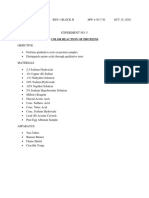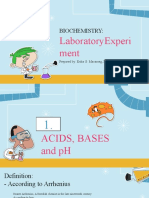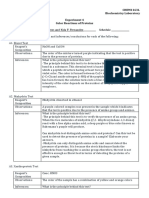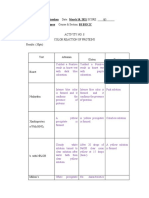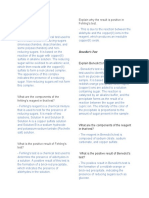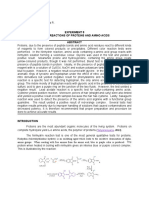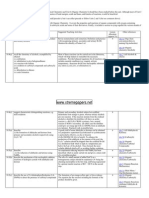P2. Laboratory Exam. Part 1: Test For Amino Acids
P2. Laboratory Exam. Part 1: Test For Amino Acids
Uploaded by
Allejah Jane CantaCopyright:
Available Formats
P2. Laboratory Exam. Part 1: Test For Amino Acids
P2. Laboratory Exam. Part 1: Test For Amino Acids
Uploaded by
Allejah Jane CantaOriginal Title
Copyright
Available Formats
Share this document
Did you find this document useful?
Is this content inappropriate?
Copyright:
Available Formats
P2. Laboratory Exam. Part 1: Test For Amino Acids
P2. Laboratory Exam. Part 1: Test For Amino Acids
Uploaded by
Allejah Jane CantaCopyright:
Available Formats
Biochemistry Laboratory
P2. Laboratory Exam. Part 1
Instructions: Research and complete the table below with information that are essential for further understanding
of Carbohydrates and Proteins. This will be the part one of your examination in laboratory, the second half or
practical exam will be an oral recitation regarding this topic so make sure that you are familiar with these tests.
The oral examination will be on April 25, 2021 at 1 PM.
Note: This is a group examination, indicate which group member is assigned for each tests. Deadline for this
research activity will be on April 25, 2021 at 5 PM.
TEST FOR CARBOHYDRATES
I. General test for carbohydrates
Test Principle Reagent End-product Interfence
Molish test Concentrated sulphuric acid Molish reagent 5- hydroxymethyl Positiveresult purple
hydrolyses glycosidic bonds - alphanaphthol furfural (bottom ring on the junction
Use/ Purpose: to give the in 95% ethanol reaction) and furfural
-specific for monosaccharaides, which (top reaction) Negative result: No
carbohydrates are then dehydrated to H2so4 purple ring on the
furfural and its derivatives. junction
Anthrone test
II. Test For Carbohydrates Based On Their Ability To Form Furfural And Its Derivatives
Test Principle Reagent End-product Interference
Seliwanoff’s test
Bial’s orcinol test
Mucic acid test
1|Page
Biochemistry Laboratory
III. Test For Carbohydrates Based On The Reducing Property Of Sugars Define:
a. Reducing sugars
b. Non- Reducing Sugars
Test Principle Reagents End-product Interferences
Benedict’s test
Barfoed’s test
Nylander’s test
Tollen’s test
TEST FOR AMINO ACIDS
General Tests for Amino acid
BRIONES, CHERUBIN FAITH T.
Test Principle Reagent Results
Biuret Test Biuret test is a general Copper sulfate (CuSO40 Biuret test positive:
Use/Purpose: test for compounds Sodium hydroxide color changes to purple
A Biuret test is a chemical test having a peptide bond. (NaOH) all peptides and protein
used to determine the presence Biuret is a compound give the test positive
of a peptide bond in a formed by heating urea Sodium potassium
substance. to 180° C. When biuret tartarate (commonly Histidine is the only
is treated with dilute known as Rochelle salt) amino acid that give
copper sulfate in biuret test positive.
alkaline condition, a
purple colored Biuret test negative:
compound is formed.
This is the basis of No color change
biuret test widely used
for identification of
proteins and amino
acids.
The principle of biuret
test is conveniently
used to detect the
presence of proteins in
biological fluids.
Xanthoproteic Test Xanthoproteic test is used to Concentrated Nitric When yellow colour appears, it
Use/Purpose: detect amino acids containing acid means aromatic amino acid is
this test is used to an aromatic nucleus (tyrosine, Original solution present in the solution.
differentiate aromatic tryptophan and Aqueous ammonia
amino acids which give phenylalanine) in a protein
positive result from solution which gives yellow color
other amino acids nitro derivatives on heating with
conc. HNO3. The aromatic
benzene ring undergoes nitration
to give yellow colored product.
Phenylalanine gives negative or
weakly positive reaction though
this amino acid contains aromatic
nucleus because it is difficult to
nitrate under normal condition.
On adding alkali to these nitro
derivative salts, the color change
from yellow to orange
Ninhydrin The amino group belonging to a Dissolve 0.35g of The presence of a
Use/Purpose: free amino acid undergoes a ninhydrin in 100 ml ethanol purple-colored complex in
The ninhydrin test is a chemical chemical reaction with ninhydrin, (iso-propanol or 1:1 the tube represents a
test which is used to check which behaves as an oxidizing mixture of acetone/butanol positive result and indicates
whether a given analyte contains agent. When exposed to may be used instead of the presence of amino acid
amines or α-amino acids. ninhydrin, the amino acid ethanol). in the sample.
undergoes oxidative Diluent solvent (for the The absence of the
deamination, resulting in the quantitative test): Mix complex in the tube
liberation of CO2, NH3, and an equal volumes of water and represents a negative result
aldehyde along with hydrindantin n-propanol. and indicates the lack of
(which is a reduced form of Standard solution (1% amino acids in the sample.
ninhydrin). protein solution)
Sample solution
Now, the ammonia goes on to
react with another ninhydrin
molecule to form diketohydrin
(which is also known as
Ruhemann’s complex). This
complex is responsible for the
deep blue colour. When the
analyte contains Imino-acids like
proline, a yellow coloured
complex is formed. When
asparagine is used, the colour of
the resulting complex is brown.
Test for Amino Acids
Test Principle Reagent Results
Millon’s test
Lead Acetate Test or
Sulfur Test
Sakaguchi Test
2|Page
You might also like
- SC22a Alkanes and AlkenesDocument10 pagesSC22a Alkanes and AlkenesEmaadB EmaadBNo ratings yet
- Crissamil Aquino-Biolab Activity 7Document4 pagesCrissamil Aquino-Biolab Activity 7Sebs Berebs100% (1)
- Color Reactions of Protein Lab ReportDocument2 pagesColor Reactions of Protein Lab ReportIsaac Aguillon33% (12)
- Biochemistry For Medical Laboratory Science (Laboratory)Document4 pagesBiochemistry For Medical Laboratory Science (Laboratory)No One100% (3)
- Surfactants CONDEADocument55 pagesSurfactants CONDEAMohamed HalemNo ratings yet
- Qualitative Tests On Amino Acids and ProteinsDocument9 pagesQualitative Tests On Amino Acids and ProteinsCorine RepatoNo ratings yet
- Biochemistry - Lab Term01: Ninhydrin Reaction Detects The Presence Amino Group PrincipleDocument4 pagesBiochemistry - Lab Term01: Ninhydrin Reaction Detects The Presence Amino Group PrincipleJohn Daniel AriasNo ratings yet
- Biochem LabDocument24 pagesBiochem Lab813 cafeNo ratings yet
- Yusop Nurshaima S.Document10 pagesYusop Nurshaima S.SHYMALEE SUZANNE REYNADONo ratings yet
- Experiment 1B NotesDocument5 pagesExperiment 1B NotesCharlie AbagonNo ratings yet
- Color Reaction of ProteinsDocument28 pagesColor Reaction of ProteinsKae ArturiaNo ratings yet
- BiochemDocument26 pagesBiochemGhel GarciaNo ratings yet
- Lab Notes For Module 567 BiochemDocument12 pagesLab Notes For Module 567 BiochemRexxie PabualanNo ratings yet
- Worksheet - Experiment 4 Color Reactions of ProteinsDocument3 pagesWorksheet - Experiment 4 Color Reactions of ProteinsYuraNo ratings yet
- Activity 2 Proteins Group 1Document7 pagesActivity 2 Proteins Group 1Althea Aubrey AgbayaniNo ratings yet
- Qualitative Color Reactions of AlbuminDocument6 pagesQualitative Color Reactions of AlbuminJustin Victor AngNo ratings yet
- Ferhaeeza Kalayakan - Activity # 8 Worksheet - Color Reactions of ProteinsDocument5 pagesFerhaeeza Kalayakan - Activity # 8 Worksheet - Color Reactions of ProteinsFerhaeeza JalaidiNo ratings yet
- Biochem ProteinDocument40 pagesBiochem ProteinCharlene SibugNo ratings yet
- Laboratory Activity 4 ProteinsDocument12 pagesLaboratory Activity 4 Proteinsleighzy lalaNo ratings yet
- Qualitative TestsDocument36 pagesQualitative Testsanirbanmanna88320No ratings yet
- VI. AnalysisDocument5 pagesVI. AnalysisAdrian Alvinson NazarenoNo ratings yet
- Experiment No. 2 - ClaritoDocument4 pagesExperiment No. 2 - ClaritoQuincy Mary ClaritoNo ratings yet
- Lab Activity 5 Color Test For Proteins and Specific Amino AcidsDocument4 pagesLab Activity 5 Color Test For Proteins and Specific Amino AcidsAkira Poscablo PiranteNo ratings yet
- Proteins and Amino Acids IDocument8 pagesProteins and Amino Acids Imarice marquezNo ratings yet
- BiochemDocument3 pagesBiochemPaulene Marie SicatNo ratings yet
- Lab Act 4Document2 pagesLab Act 4Ma Anna Cris LumongsudNo ratings yet
- Type of TestDocument3 pagesType of TestNikko ReyesNo ratings yet
- Adil, Bernadette T. BSN - 1C Activity No. 6. ANSWERSHEETDocument3 pagesAdil, Bernadette T. BSN - 1C Activity No. 6. ANSWERSHEETReiko SakaeNo ratings yet
- Biochemistry Protein and Amino Acids - Lab Sheet - (2) - CompressedDocument9 pagesBiochemistry Protein and Amino Acids - Lab Sheet - (2) - CompressedTum Tum ChongNo ratings yet
- Qualitative Analysis of Intact and Acid Hydrolysate Casein: Color ReactionsDocument6 pagesQualitative Analysis of Intact and Acid Hydrolysate Casein: Color ReactionsNatalie CuNo ratings yet
- Test For Protein Identification: Activity 8 Biochemistry LaboratoryDocument41 pagesTest For Protein Identification: Activity 8 Biochemistry LaboratorysdeoffreyNo ratings yet
- Color Reactions Intact Protein (Gluten) Basic HydrolysisDocument6 pagesColor Reactions Intact Protein (Gluten) Basic HydrolysisJennifer CamaNo ratings yet
- 2A Final - Group 4Document3 pages2A Final - Group 4Cham MuñezNo ratings yet
- Color Reactions of Protein Lab ReportDocument2 pagesColor Reactions of Protein Lab ReportBlack PastelNo ratings yet
- Color Reactions R&DDocument2 pagesColor Reactions R&DJennifer HerediaNo ratings yet
- Mod 7 8Document11 pagesMod 7 8Colene MoresNo ratings yet
- Chemistry 100Document7 pagesChemistry 100Maria Romelyn MontajesNo ratings yet
- Color Reactions of Casein Protein and HydrolysateDocument6 pagesColor Reactions of Casein Protein and HydrolysateBianca OcampoNo ratings yet
- MLS 5a - BSMLS2-E - Module4 - Group9Document8 pagesMLS 5a - BSMLS2-E - Module4 - Group9Lexi Evonne NacionalesNo ratings yet
- Chem 528 - Activity 5Document4 pagesChem 528 - Activity 5Aries Jay ReyesNo ratings yet
- Postlab Discussion Expt 2 Detection of Carbohydrates, Proteins and LipidsDocument19 pagesPostlab Discussion Expt 2 Detection of Carbohydrates, Proteins and LipidsDale Miko SanchezNo ratings yet
- Color Reactions of Intact ProteinDocument21 pagesColor Reactions of Intact ProteinlbapascualNo ratings yet
- Proteins: Maria Virginia M. Orticio Biology Department October 3, 2012Document5 pagesProteins: Maria Virginia M. Orticio Biology Department October 3, 2012Simon VertulfoNo ratings yet
- Experiment 3 Protein and Amino Acids Test: 1.0 ObjectiveDocument10 pagesExperiment 3 Protein and Amino Acids Test: 1.0 ObjectiveGift BandaNo ratings yet
- Frormal Report GlutenDocument3 pagesFrormal Report GlutenDeza SantosNo ratings yet
- Amino Acids ProteinsDocument12 pagesAmino Acids ProteinsAthinaNo ratings yet
- Experiment 4Document4 pagesExperiment 4jamielNo ratings yet
- Qualitative Color Reactions of Intact and Acid Hydrolyzed Protein CaseinDocument3 pagesQualitative Color Reactions of Intact and Acid Hydrolyzed Protein CaseinPatricia ChongNo ratings yet
- Initial Lab 6Document4 pagesInitial Lab 6Algenne AmiruddinNo ratings yet
- Experiment On Color ReactionsDocument4 pagesExperiment On Color ReactionsMarianne R. Lorenzo100% (1)
- Biochemistry Laboratory 789456123Document3 pagesBiochemistry Laboratory 789456123clienteditingaccNo ratings yet
- Biochem Assignment Qualitative Test For Proteins and Amino AcidsDocument3 pagesBiochem Assignment Qualitative Test For Proteins and Amino AcidsSophia BazarNo ratings yet
- Proteins Test PrinciplesDocument2 pagesProteins Test Principlesjago.dawal.swuNo ratings yet
- Test Description/ Characteris Tics Reagents Procedure Product Responsible For Color Positive Result Biuret TestDocument4 pagesTest Description/ Characteris Tics Reagents Procedure Product Responsible For Color Positive Result Biuret TestYroen Faith D. TalonNo ratings yet
- 2207 - Biuret TestDocument2 pages2207 - Biuret TestSubhashree SadangiNo ratings yet
- Biruet TestDocument2 pagesBiruet TestPramitabha BaralNo ratings yet
- Liebermann Nitroso Test and Ninhydrin TestDocument4 pagesLiebermann Nitroso Test and Ninhydrin Testartemis MontecastroNo ratings yet
- Basic Hydrolysis Formal ReportDocument5 pagesBasic Hydrolysis Formal ReportJessica Velasquez GuanlaoNo ratings yet
- Practical Manual of Analytical ChemistryFrom EverandPractical Manual of Analytical ChemistryRating: 4.5 out of 5 stars4.5/5 (3)
- Enantioselective Synthesis of Beta-Amino AcidsFrom EverandEnantioselective Synthesis of Beta-Amino AcidsEusebio JuaristiNo ratings yet
- Advanced Pharmaceutical analysisFrom EverandAdvanced Pharmaceutical analysisRating: 4.5 out of 5 stars4.5/5 (2)
- Naming AlcoholsDocument9 pagesNaming AlcoholsMary Margaret "MM" A. Avena0% (1)
- Plaster of Paris Bombay Maharashtra IndiaDocument7 pagesPlaster of Paris Bombay Maharashtra IndiaplastoartNo ratings yet
- Resep KulitDocument4 pagesResep KulitAnonymous vwi2Fc2BINo ratings yet
- PHARM 122 7 CycloalkanesDocument19 pagesPHARM 122 7 CycloalkanesTrixie Anne FelicitasNo ratings yet
- CI SSCK1623 Organic Chemistry For Engineering 20192020-2 PDFDocument5 pagesCI SSCK1623 Organic Chemistry For Engineering 20192020-2 PDFKavinesh GanesanNo ratings yet
- Jee 2014 Booklet7 HWT Oxygen Containing Organic Compounds IIDocument10 pagesJee 2014 Booklet7 HWT Oxygen Containing Organic Compounds IIvarunkohliinNo ratings yet
- Alcohol, Phenol Ether Complete Notes 022 023Document17 pagesAlcohol, Phenol Ether Complete Notes 022 023adityasinghnegi426No ratings yet
- Organic Reaction ListDocument2 pagesOrganic Reaction Listcxmsq6rry2No ratings yet
- IUPAC Nomenclature - 3Document50 pagesIUPAC Nomenclature - 3abhilashkumar2025No ratings yet
- Sr. No. Reaction Reagent Condition Mechanism Example NoteDocument3 pagesSr. No. Reaction Reagent Condition Mechanism Example NoteAbbas HaiderNo ratings yet
- Chem 234 Course OutlineDocument5 pagesChem 234 Course OutlineDP CHANNELNo ratings yet
- Amines: 2.1 Structure 2.2 Chemical Properties 2.3 PreparationsDocument6 pagesAmines: 2.1 Structure 2.2 Chemical Properties 2.3 PreparationsSarah FeyNo ratings yet
- Beta Oxidation of Fatty AcidDocument5 pagesBeta Oxidation of Fatty Acidkshaf muzammil100% (1)
- ALKOXYLATESDocument9 pagesALKOXYLATESDharmendra B MistryNo ratings yet
- ALKENEDocument27 pagesALKENEChane ReponteNo ratings yet
- 9701 Y03 SW 5Document4 pages9701 Y03 SW 5Hubbak KhanNo ratings yet
- Haloalkanes & HaloarenesDocument38 pagesHaloalkanes & HaloarenesVINOD KUMAR MEENA PGT CHEMISTRY, KVS100% (1)
- Subcritical Water Hydrolysis of Fresh and Waste Cooking Oils To Fatty Acids Followed by Esterification To Fatty Acid Methyl Esters Detailed Characterization of Feedstocks and ProductsDocument14 pagesSubcritical Water Hydrolysis of Fresh and Waste Cooking Oils To Fatty Acids Followed by Esterification To Fatty Acid Methyl Esters Detailed Characterization of Feedstocks and ProductsCemerlang StudiNo ratings yet
- XII Chemistry Organic Chemistry Important CBSE QuestionsDocument16 pagesXII Chemistry Organic Chemistry Important CBSE Questionsanshikaraj1010No ratings yet
- Introduction To Naming and Drawing of Carboxylic Acids and EsterDocument38 pagesIntroduction To Naming and Drawing of Carboxylic Acids and Esterkartika.pranotoNo ratings yet
- Revision Notes On AlcoholsDocument13 pagesRevision Notes On AlcoholsMuredzwa MuzendaNo ratings yet
- Amines PDFDocument20 pagesAmines PDFVankala BhaskarNo ratings yet
- The Essential Guide To Fatty Acid Analysis - Eurofins USADocument2 pagesThe Essential Guide To Fatty Acid Analysis - Eurofins USASmit patelNo ratings yet
- OBATDocument104 pagesOBATDian Meta SihombingNo ratings yet
- Marine Line, Cargo Resistance GudeDocument99 pagesMarine Line, Cargo Resistance GudeКолиш НиколайNo ratings yet
- Smart LabDocument4 pagesSmart LabMuhamad AfidinNo ratings yet
- Funkcionalne GrupeDocument7 pagesFunkcionalne GrupeAna BozinovaNo ratings yet
- LGHH Chemical Product Catalog V1Document4 pagesLGHH Chemical Product Catalog V1Akmal CoinNo ratings yet


